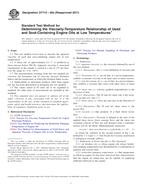Potřebujeme váš souhlas k využití jednotlivých dat, aby se vám mimo jiné mohly ukazovat informace týkající se vašich zájmů. Souhlas udělíte kliknutím na tlačítko „OK“.
ASTM D7110-05a(2011)
Standard Test Method for Determining the Viscosity-Temperature Relationship of Used and Soot-Containing Engine Oils at Low Temperatures (Includes all amendments And changes 1/21/2015).
Automaticky přeložený název:
Standardní zkušební metoda pro stanovení viskozity na teplotě Vztah použitých a sazí obsahujících oleje motoru při nízkých teplotách
NORMA vydána dne 1.1.2011
Informace o normě:
Označení normy: ASTM D7110-05a(2011)
Poznámka: NEPLATNÁ
Datum vydání normy: 1.1.2011
Kód zboží: NS-37580
Počet stran: 7
Přibližná hmotnost: 21 g (0.05 liber)
Země: Americká technická norma
Kategorie: Technické normy ASTM
Anotace textu normy ASTM D7110-05a(2011) :
Keywords:
borderline pumping temperature, critical pumpability temperature, critical pumpability viscosity, engine oil, gelation, Gelation Index, Gelation Index Temperature, low-temperature engine oil pumpability, low-temperature rheology, Scanning Brookfield technique, sooted oils, temperature-scanning technique, used oils, viscosity, ICP-AES (inductively-coupled plasma atomic emission spectrometry), Middle distillate fuels, Scanning Brookfield technique, Viscosity, Borderline pumping temperature (BPT)
Doplňující informace
| Significance and Use | ||||||||
|
Significance of Low Temperature, Low Shear Rate, Engine Oil Rheology—The low-temperature, low-shear viscometric behavior of an engine oil, whether new, used, or sooted, determines whether the oil will flow to the sump inlet screen, then to the oil pump, then to the sites in the engine requiring lubrication in sufficient quantity to prevent engine damage immediately or ultimately after cold temperature starting. Two forms of flow problems have been identified, flow-limited and air-binding behavior. The first form of flow restriction, flow-limited behavior, is associated with the oil's viscosity; the second, air-binding behavior, is associated with gelation. Significance of the Test Method—The temperature-scanning technique employed by this test method was designed to determine the susceptibility of the engine oil to flow-limited and air-binding response to slow cooling conditions by providing continuous information on the rheological condition of the oil over the temperature range of use. , , In this way, both viscometric and gelation response are obtained in one test. Note 1—This test method is one of three related to pumpability related problems. Measurement of low-temperature viscosity by the two other pumpability test methods, D3829 and D4684, hold the sample in a quiescent state and generate the apparent viscosity of the sample at shear rates ranging up to 15 s-1 and shear stresses up to 525 Pa at a previously selected temperature. Such difference in test parameters (shear rate, shear stress, sample motion, temperature scanning, and so forth) can lead to differences in the measured apparent viscosity among these methods with some test oils, particularly when other rheological factors associated with gelation are present. In addition, the three methods differ considerably in cooling rates. Gelation Index and Gelation Index Temperature—This test method has been further developed to yield parameters called the Gelation Index and Gelation Index Temperature. The first parameter is a measure of the maximum rate of torque increase caused by the rheological response of the oil as the oil is cooled slowly. The second parameter is the temperature at which the Gelation Index occurs. |
||||||||
| 1. Scope | ||||||||
|
1.1 This test method covers how to measure the apparent viscosity of used and soot-containing engine oils at low temperatures. 1.2 A shear rate of approximately 0.2 s-1 is produced at shear stresses below 200 Pa. Apparent viscosity is measured continuously as the sample is cooled at a rate of 3°C per hour over the range of −5 to −40°C. 1.3 The measurements resulting from this test method are viscosity, the maximum rate of viscosity increase (Gelation Index) and the temperature at which the Gelation Index occurs. 1.4 Applicability to petroleum products other than engine oils has not been determined in preparing this test method. 1.5 The values stated in SI units are to be regarded as standard. No other units of measurement are included in this standard. 1.6 This standard does not purport to address all of the safety concerns, if any, associated with its use. It is the responsibility of the user of this standard to establish appropriate safety and health practices and determine the applicability of regulatory limitations prior to use. |
||||||||
| 2. Referenced Documents | ||||||||
|
Doporučujeme:
EviZak - všechny zákony včetně jejich evidence na jednom místě
Poskytování aktuálních informací o legislativních předpisech vyhlášených ve Sbírce zákonů od roku 1945.
Aktualizace 2x v měsíci !
Chcete vědět více informací? Podívejte se na tuto stránku.




 Cookies
Cookies
